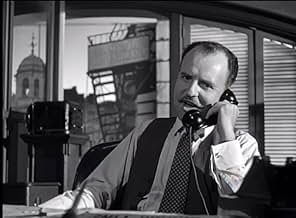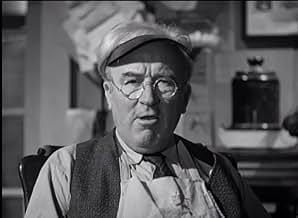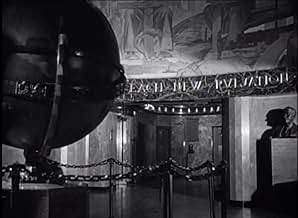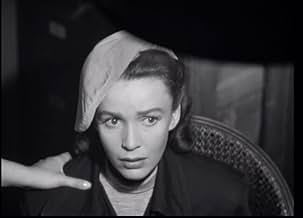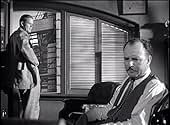अपनी भाषा में प्लॉट जोड़ेंThe story of the fight of a small-town newspaper to free an innocent girl of a murder charge, with the publisher of a metropolitan city newspaper heading, by forced circumstances, the opposi... सभी पढ़ेंThe story of the fight of a small-town newspaper to free an innocent girl of a murder charge, with the publisher of a metropolitan city newspaper heading, by forced circumstances, the opposing forces.The story of the fight of a small-town newspaper to free an innocent girl of a murder charge, with the publisher of a metropolitan city newspaper heading, by forced circumstances, the opposing forces.
- निर्देशक
- लेखक
- स्टार
- Carl Durham
- (as Howard da Silva)
- Munsey's Assistant
- (बिना क्रेडिट के)
फ़ीचर्ड समीक्षाएं
For its time, the movie's about as cynical as they come. Still, this crime drama's a genuine sleeper with few punches pulled until the Code enforced ending that unfortunately isn't very convincing. What the story does show in fairly unsparing style is how corruption can reach into a town's highest levels. The narrative is pretty plot heavy so you may need the proverbial scorecard. But it's an intelligent screenplay, providing plausible motivation for the various misdeeds.
I suspect the movie's title comes from the role the underworld plays in doing the dirty work for more respectable members of society, and then exploiting the connection for nefarious purposes (Stanton & Durham). It's the connection between the two worlds that appears to be the main theme. DeSilva plays the mob boss in unusually jovial fashion (perhaps too much), along with occasional hints of snarling menace.
I wouldn't expect a cheerleader type like Gale Storm to be in a crime movie, but she does a believable job as the struggling suburban publisher, put into a fix by her recently deceased dad. I kept expecting something to develop between her and the high-powered Reese, but this is not a movie of clichés.
As I recall, the film was taken to task for casting a white woman (Anderson) in the important role of the "Negro" maid Molly. Now, there's a question of why the maid would be made a Black woman in the first place since her race is not a factor in plot development. And second, why cast an obvious white woman in the part, which only invites unneeded curiosity. I'm not sure what the answers are, but leftist writer Blankfort and director Endfield may have wanted to make a racial statement that didn't make it to the screen. But whatever the reason, the casting remains a false note in an otherwise thoughtful screenplay.
Several notable social themes do emerge. Note how easily a well-meaning public is fleeced by Reese and the shyster lawyer, after offering up their hard earned money to the defense committee. Then there's the town's wealthy establishment that can ruin anyone who crosses them, including Reese and his newspaper. Or the yellow journalism that will print whatever promises to make money. Just as importantly, these key topics play out in fairly subtle, non-preaching fashion.
Director Endfield shows here, as in his powerful Sound of Fury, aka Try and Get Me (1950), that given the chance away from his Joe Palooka programmers, he could do social conscience films with the best of them. Note the many careful touches in this film—the shabby people lined up to donate to the defense committee, the defining bust of Napoleon discretely behind editor Lee's (Dunne) desk, Lee slyly opening the door behind Reese despite what he's saying. Too bad Endfield finished his career in England after falling victim to the blacklist.
All in all, the movie's not as powerful as Sound of Fury, but it does avoid clichés and remains consistently engaging and unpredictable. Endfield appears fascinated in both films with yellow journalism and how it's used to exploit society, a worthy topic for any period. Editor Reese is nothing if not entrepreneurial in his schemes, with the money-making ideas spitting out as fast as a machine gun. It's an impressive lead performance by the great Duryea. Anyway, except for the occasionally cheap sets and unconvincing climax, this obscure indie production remains a genuine sleeper.
It carries the Warner Bros. patina - a gritty crime melodrama with a mix of social commentary and thick-ear rough stuff, and with a curious collection of supporting characters. Howard Da Silva, Gale Storm, Michael O'Shea and Harry Shannon all do themselves credit and Herbert Marshall(?) also manages to fit in.
This is a good semi-noir. It starts off as one but switches in mid-picture to straight drama and then back again. Only 90" long, it holds your interest throughout. It may not sound promising but sometimes you can't judge a movie by its title.
A mash-up of newspaper drama, small-town expose, and gangster picture, some of this works, but not a lot. The Reese character is neither helped or hindered by the casting of Duryea: if it was the filmmakers' intention to keep the audience guessing whether or not he was a slime ball at heart or was decent beneath the surface, then Duryea is a good pick, as I still wasn't sure by the end how much of a creep he really was. I say all of this as somebody who is an overall big fan of Dan Duryea. Marshall was awful, turning in an amateur-level performance during his big emotional scenes, although he was never exactly great at that kind of thing. Gale Storm didn't make much of an impression, either. Howard DaSilva has a couple of good scenes as the chief gang boss. This was the final film appearance for Edward Van Sloan, who had been a mainstay in Universal's horror films of the 1930's.
Big-city reporter Dan Duryea finds himself in a jam that makes him persona non grata to his newspaper, the district attorney's office and underworld boss Howard Da Silva. Broke and blacklisted, he buys himself a partial stake in a struggling community paper, The Lakewood Gazette, owned by Gale Storm, who's put off by his brash ways and temporizing ethics. But a headline story breaks right there in the idyllic New England town: The daughter-in-law of press baron Herbert Marshall has been murdered, and Duryea seizes the chance to run with the scoop.
It's not a whodunit, though; the killer, it's clear from the outset, is Marshall's snivelling son (Gar Moore, who sounds like HAL the computer). But when the murdered woman's black maid (Mary Anderson) goes missing, Marshall sees opportunity to whip up public sentiment against her. Storm, who knew the maid, trusts in her innocence; Duryea, on the other hand, waits to see which outcome might profit him most. When The Gazette starts a defense fund for Anderson, Marshall and his son start running scared and seek a favor from Da Silva to put a stop to the tenacious Duryea, who's been won over by Storm....
The Underworld Story's a modest movie that's well put together (it looks great, too, photographed by Stanley Cortez, who also shot The Magnificent Ambersons and Night of the Hunter). But it belongs to Duryea, who could play affable but slithery better than anybody, and his twists and turns keep us guessing.
Reminiscent of 30s socially-conscious cinema more than film noir, The Underworld Story also shows that decade's story-telling verve. It's been purged of preaching, so when one character remarks `Looks like they're burning witches again,' we suddenly recall that its release came in the midst of the Hollywood anti-Communist witch hunt, and that at least two of its principals director Cy Endfield and Da Silva were among its victims.
क्या आपको पता है
- ट्रिवियाThe "N" word is overdubbed with "Negro" on at least two occasions. [Note: this may be a local station's practice; the version shown on TCM contains the uncensored language.]
- गूफ़At the funeral, there is a headstone marked "Robert Elis 1720-1777". After the service, as the mourners are leaving, the same headstone appears in a completely different place.
- भाव
District Attorney Ralph Munsey: Take it easy, Reese. Things are tough all over. Pretty soon a man won't be able to sell his own mother.
- इसके अलावा अन्य वर्जनThe manufacture-on-demand DVD from Warner Archive Collection has the opening and closing 1992 Warner Bros. Pictures logos.
- कनेक्शनReferences The Song of Bernadette (1943)
टॉप पसंद
- How long is The Underworld Story?Alexa द्वारा संचालित
विवरण
- रिलीज़ की तारीख़
- कंट्री ऑफ़ ओरिजिन
- भाषा
- इस रूप में भी जाना जाता है
- The Whipped
- फ़िल्माने की जगहें
- Los Angeles City Hall - 200 North Spring Street, Downtown, लॉस एंजेल्स, कैलिफोर्निया, संयुक्त राज्य अमेरिका("The Turk" was murdered on the steps of City Hall)
- उत्पादन कंपनी
- IMDbPro पर और कंपनी क्रेडिट देखें
- चलने की अवधि1 घंटा 31 मिनट
- रंग
- पक्ष अनुपात
- 1.37 : 1
इस पेज में योगदान दें



